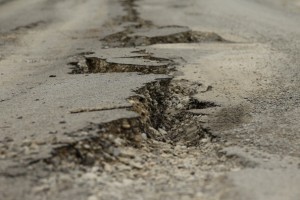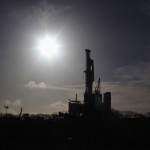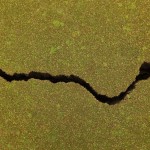More on the Science Linking Fracking Disposal Wells to Earthquakes

Photo by Cameron Spencer/Getty Images
Scientists have drawn definitive links between hydraulic fracturing disposal wells and induced earthquakes. The photo above shows a crack in a road after a natural earthquake in 2011 in Christchurch, New Zealand.
Earlier today we reported on a series of quakes rattling Johnson County, outside of Fort Worth, Texas. The quakes haven’t caused any significant damage, but for a part of the state that has historically been seismically quiet, they’ve come as a surprise. There happen to be dozens of disposal wells — deep injection wells used for disposing of wastewater from hydraulic fracturing, or “fracking” — in the same area as the quakes. So where’s the science linking earthquakes in the area to those wells?
“There is definitely a credible link between wastewater disposal, primarily related to production of gas from the Barnett Shale, with earthquakes,” William Ellsworth, a seismologist with the US Geological Survey, tells StateImpact Texas. But it’s important to note that for the most part, these quakes have done little damage. “At this point the earthquakes are a bit of an annoyance, certainly, and there’s always the possibility that something larger might occur,” Ellsworth says.
Elllsworth was one of the authors of a study from April linking disposal wells and other drilling activity to earthquakes.
That group looked at quakes measuring 3.0 or higher on the Richter scale. It found that quakes have increased in frequency and intensity, beginning in 2001. In 2009, there were 50 quakes in the midcontinent region. In 2010, 87. And last year, the number jumped to 134. That’s a sixfold increase over earthquake frequency in the 20th century, according to the report.
“A naturally-occurring rate change of this magnitude is unprecedented outside of volcanic settings or in the absence of a main shock, of which there were neither in this region,” the abstract reads.
Then there’s a report from the National Academy of Sciences (NAS) commissioned by the Department of Energy. It reads: “A string of small seismic events in Arkansas, Ohio, Oklahoma, and Texas in the past several years has been related to waste water disposal associated with oil and gas production. These seismic events have brought the issue of induced (human-caused) seismicity firmly into public view.”
Again, from the NAS report: “These events have not resulted in loss of life and generally have not caused significant structural damage, but their effects were felt by local residents, and have drawn the issue of induced seismicity into public view.”
Here is a map from that report linking an earthquake in the Ft. Worth area to an injection well, as well as dozens of other quakes the U.S. linked to drilling and disposal wells:
There are more than 36,000 wells permitted for wastewater injection in Texas, according to the report.
“We’re going to cause more events as we drill more wells,” geologist Murray Hitzman of the Colorado School of Mines, who led the study, told NPR last month. “I think there’s not much question about that. But we understand what’s happening pretty well and I think we can get in place, without too much problem, protocols and systems so that we can deal with it in a very reasonable way.”
And yet another study, from Stanford University professors. That looked at large-scale carbon sequestration. Taking carbon dioxide out of the air, or off the stacks of plants and refineries, and pumping it underground. That study found that “there is a high probability that earthquakes will be triggered by injection of large volumes of CO2 into the brittle rocks commonly found in continental interiors.” And because earthquakes could ruin the seal on those wells, then the carbon could leak. “In this context, large-scale CCS is a risky, and likely unsuccessful, strategy for significantly reducing greenhouse gas emissions,” the study says.
The idea that pumping billions of gallons of wastewater underground could induce seismic activity isn’t particularly new. “In the scientific community, it was pretty much established in the 1960s that injecting fluids into the ground sometimes causes earthquakes,” Dr. Cliff Frohlich, Associate Director of and Senior Research Scientist at the Institute of Geophysics at the University of Texas at Austin, said in an interview with us in February.
“The earthquakes are occurring more frequently now because there’s so much more fluid injection due to the fracking and the development of unconventional gas,” he said. “This unconventional gas boom is huge. The Fort Worth basin covers 15 counties, and the Marcellus Shale covers vast portions of Pennsylvania, West Virginia, and New York. The Bakken Shale covers one-third of North Dakota. These have the potential to provide enormous amounts of energy. So what’s happened is that we have a lot more injection going on in a lot more places, where we’re producing more gas and earthquakes.”
As Frohlich notes, Texas isn’t alone in experiencing induced earthquakes linked to drilling injection wells. Ohio experienced a magnitude 4.0 earthquake earlier this year near the town of Youngstown. The New York Times reported that Ohio officials believe this quake, the eleventh such event in Youngstown in 2011, was the result of disposal wells.
So what can be done? “If disposal is causing earthquakes you can find a different way of dispose of it,” Frohlich told us in another interview this June. “You can dispose of the stuff in a different well, or you can even take it to a fluid treatment plant. [But] the people involved in this are going to do the cheapest way of doing things that is generally considered safe,” he said.





